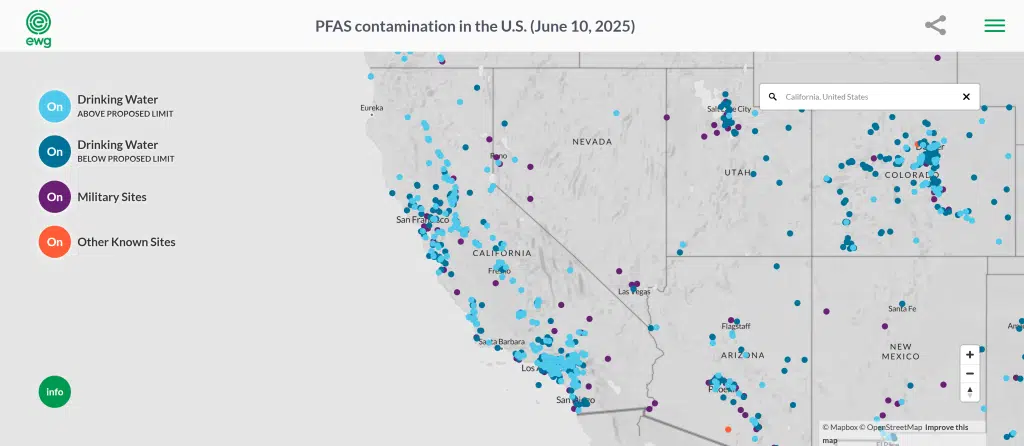- Home
- Personal Injury
- PFAS Lawsuit
- PFAS Contamination Map
- PFAS in California
PFAS in California
- Last updated: July 16, 2025
-
Contributor: nicky

I first became aware of PFAS California concerns when I read that these chemicals, sometimes called “forever chemicals,” had been detected in multiple communities across the state. The more I investigated, the more I realized how extensive the contamination is. Manufacturers often used PFAS (per- and polyfluoroalkyl substances) in a wide range of products, from firefighting foam to cosmetics. PFAS do not break down easily in the environment, and some studies link them to diseases such as cancers, thyroid disorders, and other health complications. Although some forms of PFAS have been phased out, many remain in water supplies, soil, and even everyday foods across California. Through my research, I want to share what I have learned about how PFAS contamination affects Californians—and what you can do if you think you have been impacted.
What are PFAS and why are they dangerous?
PFAS are synthetic chemicals used since the mid-20th century in industrial and consumer applications. They repel water, resist oil, and can withstand high temperatures. While these traits made PFAS appealing to manufacturers, they also mean that PFAS persist in the environment for decades.
I find that PFAS are considered dangerous because:
- They bind to proteins in blood and organs, allowing long-term accumulation.
- They can pass from mother to child in breast milk.
- Some variations are linked to kidney and testicular cancer, thyroid disease, reduced vaccine response, and other health problems.
The US Environmental Protection Agency (EPA) originally moved to regulate certain PFAS but later extended compliance deadlines to 2031, creating uncertainty for many communities (research). Meanwhile, California has adopted its own public health goals and enforceable standards to protect local residents.
Where are PFAS found in California?
Because PFAS are used in so many products—firefighting foam, water-resistant fabrics, food packaging, and more—these chemicals can end up in various places. In California, PFAS pollution has been documented in:
- Urban wastewater and firefighting training sites.
- Industrial facilities that manufacture or use PFAS.
- Landfills, where PFAS leach into groundwater.
- Agricultural lands treated with biosolids that may contain PFAS.
According to a new analysis cited in the research, 25.4 million Californians are served by water systems contaminated with these chemicals. Testing continues, and experts project that the total number of people affected will grow.
I have also seen data showing that PFAS contamination can disproportionately impact disadvantaged communities. At least 8.9 million people in such areas might already be exposed, making PFAS pollution a significant environmental justice issue in California.
PFAS in California’s drinking water
From my perspective, the most alarming pathway of PFAS exposure is through drinking water. Regulatory agencies in the state have detected PFAS in numerous municipal water systems. In some regions, wells that supply hundreds of thousands of residents have been removed from service after PFAS levels exceeded safety guidelines (research). This means water agencies often have to find alternative water sources or install costly treatment systems to meet state standards.
- A statewide testing order: On October 31, 2022, the Division of Drinking Water in California issued a general order for monitoring 25 PFAS compounds at water system sources considered at risk.
- Revised thresholds: In April 2024, the California Office of Environmental Health and Hazard Assessment adopted new public health goals that drive Maximum Contaminant Levels (MCLs).
- Extended compliance: On the national level, the EPA rolled back first-ever limits on certain PFAS chemicals and extended deadlines to 2031, creating an uneven regulatory landscape across different states.
While California is stricter than many other states, the research implies that residents living near contaminated or vulnerable water sources can still be exposed. I understand that water utilities not only face compliance costs but also potential lawsuits and community backlash if contamination is detected.
PFAS in California’s soil, food, and agriculture
Beyond water, PFAS often enter the food chain through contaminated soil. Agricultural fields irrigated with PFAS-laden water or spread with biosolids can pass these chemicals into produce and livestock. A recent study focusing on California adults found seafood, eggs, and brown rice still contribute to PFAS exposure. Though older variants of PFAS have declined in various foods over the last two decades, certain compounds remain a concern.
In my opinion, these findings underscore the need for ongoing vigilance. I have seen data showing that even if water contamination in one region abates, the chemicals can linger in soil for years. Plants can absorb PFAS through irrigation water, and livestock can ingest PFAS from feed or contaminated sources. This means that, in some areas, controlling PFAS in water alone might not be enough—soil remediation and best agricultural practices also play critical roles.
Health effects of PFAS exposure
PFAS are considered bioaccumulative, meaning they can stay within the human body for long periods. Studies across the country, including those in California, have associated PFAS with:
- Immune system suppression, such as a decreased response to vaccines.
- Developmental issues in infants and children.
- Elevated cholesterol levels.
- Changes in liver enzymes.
Some data I reviewed shows that PFAS may also affect pregnancy outcomes, raising concerns about the well-being of pregnant individuals and their children. Researchers still do not fully grasp all the ways these chemicals might interact with the body over time, which is why regulators set conservative thresholds to protect public health.
PFAS-linked diseases in California
When I looked deeper into disease patterns in the state, I found four outcomes frequently linked to PFAS exposure: kidney cancer, testicular cancer, thyroid disease, and liver damage (often manifesting as abnormal cholesterol levels). Although not everyone with PFAS exposure will develop these conditions, certain medical studies highlight them as areas of concern.
Kidney cancer
Evidence suggests that exposure to chemicals such as PFOA in contaminated water may increase the risk of kidney cancer. According to research, some communities near industrial facilities or military bases had a higher incidence of kidney cancer. In California, I have seen local officials respond by testing wells and shutting down highly contaminated sources.
Testicular cancer
Testicular cancer is another potential risk. In heavily exposed populations, studies found higher-than-average rates of this disease. The EPA specifically flagged testicular tumors as a concern in areas with elevated PFAS levels. While the incidence may be relatively small, each diagnosis can still be devastating to affected families.
Thyroid disease
PFAS may also alter how the thyroid gland functions. The thyroid determines many aspects of metabolic health, so disruption can lead to weight fluctuations, energy problems, and other physiological imbalances. Some individuals in California who live near known PFAS hotspots have voiced concern about thyroid complications.
Liver damage and cholesterol changes
I have read multiple studies indicating that PFAS might cause liver damage and disrupt typical cholesterol metabolism. Data from the research suggests that individuals with higher blood levels of certain PFAS tend to exhibit elevated cholesterol. These changes may begin subtly, so regular blood tests and doctor visits are crucial if you live in an area with known PFAS contamination.
Government and regulatory response in California
California has adopted a more aggressive approach to managing PFAS compared to some other states. Even so, agencies must navigate complex federal regulations and local industry pressures. Officials also coordinate with the EPA, whose changing stance on PFAS has led to variations in compliance deadlines.
California state laws and bans on PFAS
California legislators passed measures banning PFAS in firefighting foam, juvenile products, cosmetics, textiles, and certain food-packaging materials. Sen. Nancy Skinner introduced Senate Bill 903, known as the Ending Forever Chemicals Act, which seeks to phase out the sale and distribution of unnecessary PFAS by 2030. Manufacturers can apply for exemptions only if they can prove there is currently no safer alternative.
I see this legislation as a critical step toward pollution prevention. If fewer PFAS are allowed, then fewer sources of new contamination will emerge. Additionally, the bill includes requirements for ongoing oversight, ensuring that industries continue to reduce PFAS usage wherever possible.
Role of California EPA and Water Boards
The California Environmental Protection Agency (CalEPA), along with the State Water Resources Control Board’s Division of Drinking Water, is responsible for much of the PFAS monitoring. Starting in 2023 and extending into 2025, public water systems must test for 30 chemical contaminants—29 of which are PFAS. Monitoring data is publicly reported, allowing me and many other concerned citizens to track contamination levels in local water supplies.
When unsafe levels of PFAS are found, water providers may be required to take wells offline or install specialized treatments, such as granular activated carbon or ion-exchange systems, to remove contaminants from the water. While these measures make the supply safer, they can also drive up operating costs for local agencies. Some communities worry about rate hikes or challenges finding new water sources if others become contaminated.
Can you test your water or property for PFAS in California?
Although state and federal agencies have ramped up testing efforts, I believe individuals should also take steps to learn more about their own exposure risks. Homeowners can:
- Contact local water utilities to request the latest test results for PFAS.
- Purchase a certified water test kit specifically for PFAS if municipal reports are unavailable or incomplete.
- Ask licensed environmental consultants to test private wells for PFAS if they rely on groundwater.
Property owners, especially those near known sources of contamination (industrial sites, airports, or military bases), can also benefit from soil testing. Independent labs and environmental consultants offer PFAS soil analysis for a fee. Having reliable data allows you to make more informed decisions—possibly installing filtration systems or pursuing legal options if contamination is severe.
Do you qualify for a PFAS lawsuit in California?
If your water supply or property has been contaminated with PFAS, or if you have experienced related health issues, you might qualify to file a PFAS lawsuit in California. I recommend speaking with an attorney who understands environmental litigation and personal injury law. Potential legal claims usually focus on:
- Medical expenses (treatment, diagnostic tests, ongoing care).
- Property damage (cost of filtration, lost property value).
- Wrongful death or severe health impacts.
- Class action participation if multiple local residents have been similarly harmed.
You do not have to navigate this alone. Legal Claim Assistant offers guidance on how to proceed with a possible PFAS lawsuit. If I were in your position, I would gather relevant documents, such as medical records and water test results, before pursuing legal counsel. That information will strengthen your case and help lawyers determine if you have viable claims.
Why choose Legal Claim Assistant
I have researched several legal services for PFAS cases, and Legal Claim Assistant stands out for a few reasons:
- Expertise: They understand the complexities of PFAS litigation, including state and federal regulations.
- Network of attorneys: Their connections span firms experienced in environmental law and personal injury suits, ensuring you can find the right representation for your specific situation.
- Free case review: You can request an initial evaluation at no out-of-pocket cost. That is especially important if you are already facing medical bills or expenses for filtration.
- Individualized support: Legal Claim Assistant works to match you with lawyers who are familiar with PFAS contamination in California, which is critical given the state’s specific regulatory framework.
If you want to learn more, I encourage you to visit their main PFAS resource at PFAS Lawsuit. You may also explore their Water Contamination Lawsuit page or DuPont Lawsuit resource for additional insights on national and corporate-level PFAS legal developments.
Frequently asked questions (FAQ)
PFAS contamination across California has led to growing concern—from drinking water safety to long-term health effects. Whether you’re worried about exposure, testing, or legal options, this FAQ answers common questions from residents seeking clarity and support.
In my view, PFAS contamination is both extensive and evolving. About 25.4 million people already live in areas with detectable PFAS in water supplies (research). Many others have not yet seen their water tested. As California continues monitoring wells and public water systems, the geographic scope of contamination could grow. Some of the highest levels are found in Southern California counties like Los Angeles, Orange, and Riverside, but rural and agricultural regions are also affected.
If you live in another state, you might also find PFAS contamination in your area. For instance, you can see ongoing monitoring updates in Minnesota or New York, as PFAS contamination can cross state borders.
California has enforceable drinking water standards for certain PFAS compounds, as well as public health goals that guide stricter permissible limits than federal guidelines might. The state also issues notification levels that require water utilities to inform customers if certain PFAS exceed established benchmarks. Additionally, California has passed laws banning PFAS in firefighting foam, textiles, food packaging, and other consumer products. By 2030, under Senate Bill 903, most unnecessary uses of PFAS in the state are slated for elimination.
Yes. For municipal water, start by contacting your local supplier, which is required to provide results of ongoing PFAS monitoring if they have tested. If you rely on a private well or want extra peace of mind, you can purchase a kit or hire a certified laboratory to analyze your water. In many cases, I suggest verifying that the lab specializes in PFAS testing, as it requires sensitive detection methods.
It is possible. While PFAS exposure from food has declined overall, a recent study mentioned that seafood, eggs, and brown rice still contribute to PFAS levels in California adults. Contamination can occur if crops or animals are raised in areas where PFAS infiltrate soil or water. Regulatory agencies continue to study these pathways, but I would still recommend washing produce thoroughly and being aware of advisory notices if you live near known contamination sites.
You may have legal options if you can show a link between PFAS exposure and a specific health condition, or if a company’s negligence caused contamination on your property. Water utilities may also face liability if they fail to act on known contamination. In California, lawyers specializing in environmental and toxic tort cases can provide the legal expertise required to file personal injury or property damage claims. I encourage you to consult with Legal Claim Assistant to see if your situation meets the legal thresholds for a lawsuit.
Depending on the circumstances, you might:
- File a personal injury suit against the company or entity responsible for contamination.
- Join a class action if many impacted residents share similar claims.
- Demand cleanup or treatment costs through property damage litigation.
- Seek medical monitoring coverage for ongoing health screenings related to PFAS exposure.
I find that legal assistance is invaluable in navigating complex state regulations, identifying defendants, and managing evidence. Legal Claim Assistant can connect you to an attorney prepared to handle these unique challenges.
Overview PFAS contamination in the USA
Here you van find the PFAS watercontamination map of the United States. Find, state by state, where water contamination has occurred due to PFAS exposure.
- PFAS in Alabama
- PFAS in Alaska
- PFAS in Arizona
- PFAS in Arkansas
- PFAS in California
- PFAS in Colorado
- PFAS in Connecticut
- PFAS in Delaware
- PFAS in Florida
- PFAS in Georgia
- PFAS in Hawaii
- PFAS in Idaho
- PFAS in Illinois
- PFAS in Indiana
- PFAS in Iowa
- PFAS in Kansas
- PFAS in Kentucky
- PFAS in Louisiana
- PFAS in Maine
- PFAS in Maryland
- PFAS in Massachusetts
- PFAS in Michigan
- PFAS in Minnesota
- PFAS in Mississippi
- PFAS in Missouri
- PFAS in Montana
- PFAS in Nebraska
- PFAS in Nevada
- PFAS in New Hampshire
- PFAS in New Jersey
- PFAS in New Mexico
- PFAS in New York
- PFAS in North Carolina
- PFAS in North Dakota
- PFAS in Ohio
- PFAS in Oklahoma
- PFAS in Oregon
- PFAS in Pennsylvania
- PFAS in Rhode Island
- PFAS in South Carolina
- PFAS in South Dakota
- PFAS in Tennessee
- PFAS in Texas
- PFAS in Utah
- PFAS in Vermont
- PFAS in Virginia
- PFAS in Washington
- PFAS in West Virginia
- PFAS in Wisconsin
- PFAS in Wyoming
Related Article

What Philips CPAP Machines Are Recalled and Why

